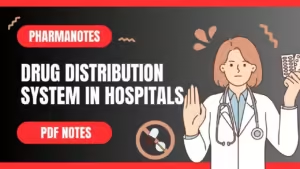Drug Distribution System in Hospitals

Hospitals make use of drugs and therapeutic substances in in-patient and out-patient departments. They are of such a variety that the patients mostly fail to understand them.
Hospitals have two types of drug distribution system.
1) Distribution of drugs to indoor patients (Patients in wards, operation theatres, X-ray, and other specified departments)
2) Distribution of drugs to outdoor patients (Patients not admitted and not occupying bed)
Out-patient Services:-
This type of patients is not admitted in hospital and is given general or emergency treatment which could be diagnosis, therapeutic, or preventive.
An out-patient department keeps a check on patients who not to be admitted and require only diagnostic and therapeutic services.
There are three types of out-patients:-
1) General out-patient: such a patient is given treatment for a general condition or emergency condition but not referred case.
E.g. Diahorrea, Hypertension, Diabetes, Fever etc.
2) Referred Out-patient: In this type patient is referred to outpatient department by the attending medical/dental practitioner for specific treatment, and the patients for further treatment returns to the practitioner.
3) Emergency out-patient: In this type patient is given emergency or accident care for conditions (Determined clinically or considered by the patient or his representative) demanding instant medical attention.
In-patient services:-
The patient which is admitted in hospital receiving general or specific treatment is called In-patient.
Types of services provided to In-patients.
1) Individual prescription order system
2) Complete floor stock system
3) Combination of individual drug order and floor stock system
4) Unit dose dispensing system
5) Bed size pharmacy
(Note: – According to Syllabus Only Unit dose dispensing system, Bed size pharmacy, floor stock system notes are Available)
Unit dose dispensing system:-
It is the system which consist of depending unit dosage to patient containing an amount of drug.
These unit dosage are either stored or distributed from many pharmacy department unit dose are prepare as per requirement it is useful to In-patients and out-patient.
Type of unit dosage form:-
They are mainly two types.
1) Centralized unit dose dispensing system:-
The unit dose are dispensing from pharmacy department.
2) Decentralize unit dose dispensing system:-
The unit dose dispensing system are dispensing from nursing station.
Advantage of unit dose dispensing system:-
• Patient should be pay the cost of medicine.
• Purchasing cost and budget of hospital.
• Paper work is less at narsing unit as well as the pharmacy.
Disadvantage of unit dose dispensing system:-
• Man power is required for prepackaging.
• Separate container machinery and also space is required.
• Unit deepening should be handle by skilled person.
Floor ward stock system:-
Floor ward stock system is seen in private hospitals. In this system the drugs are stored in the pharmacy Store, supplied to the wards when ordered and are supervised by a registered nurse at the nursing station.
Type of drugs:-
1) Charge Drugs:-
The charge floor stock medicine are given to the patient cost of medicine is directly added to the patient account.
The selected are list of charge floor stock drug and requirement.
2) Non-Charge drugs:-
The medication are stock on nursing department at all-time but they are not directly charge to account of patients.
Advantage of floor stock system:-
• Waiting period is less
• Medication can be receive immediately
• Emergency medications are easily available.
• Number of Pharmacist required for dispensing.
Disadvantage of floor stock system:-
• Medication error are not minimised.
• It increases the word load of nursing.
• Review of preparation by Pharmacist is not possible.
Central Sterile Service:-
The central supply department (CSD) in a hospital provides the essential professional supplies and equipment (Drapes, syringes, tubing, intervenous etc.)
The central supply department (CSD) and procurement, Storage, distribution and manufacturing of various sterile solutions within should be managed by the pharmacist.
Central supply department (CSD) has the following objectives.
1) Maintains operation theatres supply.
2) Cleans and sterilizes all hospital supplies.
3) Makes an accurate inventory of all hospital supplies and equipment.
4) Contributes to education programmers.
5) Develops a cost-effective programmer by cost analysis of personnel, supplies and equipment.
Location of the Central Sterile Supply Room (CSSR):
• It should be located near the operation theatres.
• The department should have been capacity to expend itself growth in future.
• It should be located near the pharmacy department.
Bed Side Pharmacy:-
• The drug distribution system is hospital in which drugs are keep near the bed of the patient so the patient taken the medicine himself.
• The pharmacist to activity going on around the patient and public health.
Medication of bed side: –
• Medication are very important to life saving drug may be kept at the bed side if so order by physician not more than one strip shall be life to the patient.
Role of Pharmacist at bed side pharmacy:-
• He shall reduce such the problem by briefly the patient about disease.
• The pharmacist of bed side pharmacy role is treatment and taken the medicine easily available.
• He guides to nursing staff and handling to saft the use of medicine.
For PDF Notes Click on Download Button
